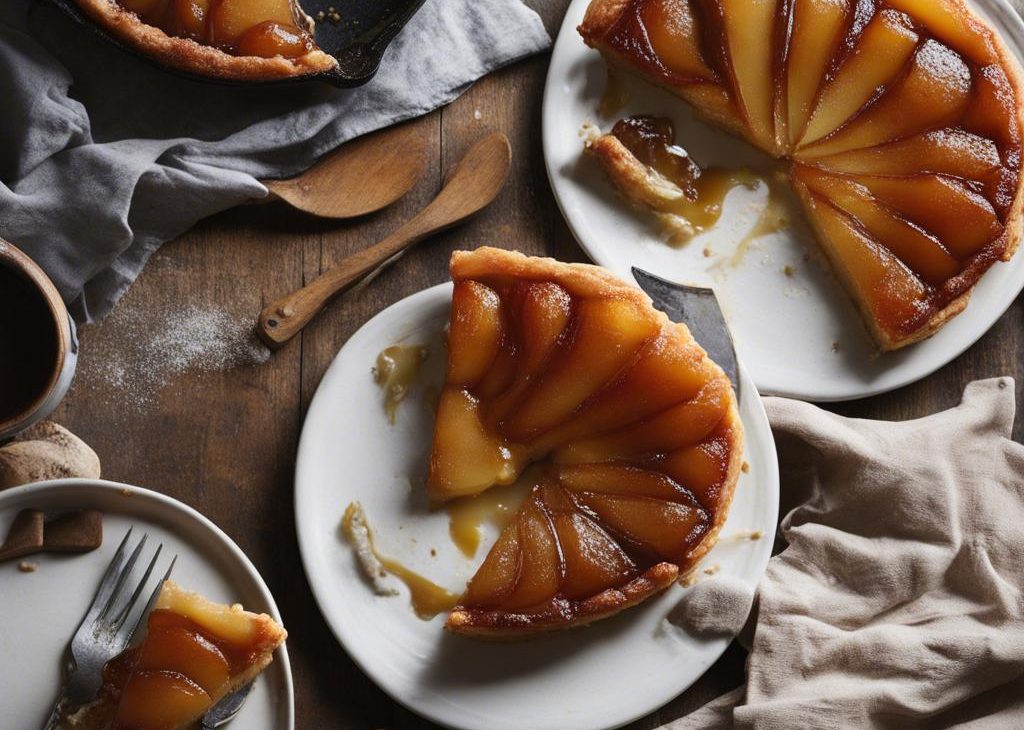


This is pear tarte tatin made simpler. A classic French dessert, tarte tatin is a rustic fruit tart served upside down. Caramelized with butter and sugar in a skillet, the fruit is then baked beneath a blanket of pastry dough—which becomes a crust once flipped. Depending how you make it, the recipe is often quite technical and complicated. I simplified the process as much as possible without compromising flavor.
There are many ways to make tarte tatin, and my team and I tried a lot of them! After several recipe fails, we finally cracked the code on how to make a deliciously spiced pear tarte tatinthat turns out consistently every time. It may not be the way they teach it in French pastry school, but our goal was to take a somewhat-daunting recipe and make it approachable and achievable for home/hobby bakers.
That is always my goal when I teach you.
Tarte tatin is named for the Tatin sisters who created it and served it at their hotel in France in the 1880s. It’s essentially fruit, usually apples or pears, caramelized in butter and sugar on the stove, topped with a round of pastry dough and baked; to serve, the dessert is inverted onto a plate so the caramelized fruit is on top and the pastry becomes a crust beneath it.
Sort of like an apple upside down cake, but more saucy and made with pastry instead of cake.
Pretty simple, oui? Mais, non. 😉 Perfecting pear tarte tatin, which only has about 8 ingredients, proved to be a much bigger challenge than my team or I expected.
This is actually the same dough we use to make apple galette. Many tarte tatin recipes call for puff pastry, but we had much better success with this crust vs. the puff pastry dough we tested at first. See recipe testing saga above!
This is a similar recipe to my all-butter pie crust, but it’s *slightly* sweeter and yields just 1 crust instead of 2. (But feel free to make the full pie crust recipe and use half for another single-crust pie like pumpkin pie, or freeze half for a future tarte tatin!)
I love how thick this crust is… think multiple flaky, buttery layers of crust for the sweet caramelized pears to nestle into. And it bakes through thoroughly, so no soggy crust situation here.
Use small, somewhat-firm Anjou pears. Bartlett, Bosc, or Comice pears are all wonderful choices, too. But you want to use pears that are small and still fairly firm so they’ll hold their shape when baking.
*Some recipes instruct you to dry out the pears before using, to help prevent them from releasing too much liquid. I did not find that necessary, especially since we aren’t pre-cooking the pears on the stove and we’re using a thicker brown sugar caramel sauce.*
Peel, slice lengthwise, cut out the stem, and scoop out the core. I use a small cookie scoop for this, but you can use a melon baller if you have one, or carefully cut out the core with a knife. Toss the pears with the lemon juice and spices.
Many recipes call for caramelizing the pears on the stove first, but we found this step unnecessary (and ended up with several ruined batches of burnt pears). Instead, you’ll cook the butter and brown sugar together, and then take it off heat before adding the pears.
I use a 10-inch cast-iron skillet for this, but if you don’t have an oven-safe skillet, you can cook the caramel in a saucepan, and then pour the caramel into a pie dish.
Arrange your pears over the hot caramel in the pan, core-side-up. You want to pack them in as tightly as possible. Once the tart is inverted after baking, you’ll be rewarded with a beautiful landscape of caramelized pear halves over top of the crust.
Roll out the pie dough and drape it over the pears. Don’t worry if the pie dough isn’t perfect; it will taste divine! There’s no crimping or fluting required, and you don’t even need an egg wash. Use a spoon to gently tuck the edges in around the pears.
Dock the crust with a fork to create some steam vents.
Bake, starting at a higher temperature at first to really begin browning and baking through the crust.
Let cool for about 10 minutes, and then very carefully (do it over the sink!) invert the warm tart onto a large (larger than the skillet) plate or serving platter.
Voila! And, for a little extra ooh la la, serving this spiced pear tarte tatin a la mode with vanilla ice cream or whipped cream is always a great idea. Bon appetit!
This is pear tarte tatin made simpler. A classic French dessert, tarte tatin is a rustic fruit tart served upside down. Caramelized with butter and sugar in a skillet, the fruit is then baked beneath a blanket of pastry dough—which becomes a crust once flipped. Depending how you make it, the recipe is often quite technical and complicated. I simplified the process as much as possible without compromising flavor..